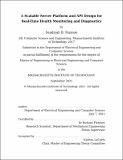A Scalable Server Platform and API Design for Real-Time Health Monitoring and Diagnostics
Author(s)
Husnoo, Saadiyah B.
DownloadThesis PDF (4.320Mb)
Advisor
Fletcher, Richard
Terms of use
Metadata
Show full item recordAbstract
Driven by the needs of the COVID-19 pandemic, remote health monitoring services have become mainstream. Machine learning and Artificial Intelligence present new opportunities for health monitoring and diagnostic support for outpatient care as well as for global health. However, currently available server platforms, particularly for research, are very primitive and fragmented, and offer little support for the development of machine learning models. To address this need, the Rich Fletcher’s group at MIT (a.k.a. the Mobile Technology Lab) has developed a server architecture, known as PyMedServer, in conjunction with a host of Mobile applications to collect and analyze patient data, with integrated support for machine learning algorithm development. While this platform was successfully used for several clinical studies, the analysis algorithms were tightly coupled with PyMedServer’s Electronic Medical Record (EMR) system, which limited who could use them and how they could be used. In addition, this initial version of PyMedServer did not support complex multi-stage data processing pipelines and did not integrate with third party applications.
In this thesis, I present specific server API concepts and UI designs for PyMedServer and how I extended PyMedServer to support new workflows both for academic research and also for third-party integration. I developed new and more robust API endpoints and workflows, while adding a two-stage data processing model in order to separate the step of signal processing (or feature extraction) from the application of the machine learning model. I created a new "anonymous" API so as to decouple the EMR system and the analysis pipeline. In addition to creating these new API’s, existing API’s were also improved with support for data privacy concerns and error codes, with the goal of providing a more useful and user friendly platform. In addition, I also implemented an improved user interface, where I extended the front end functionalities to provide additional feedback and information regarding collected data. Several examples are given of different servers and different use cases, for the purpose of illustration.
Date issued
2021-09Department
Massachusetts Institute of Technology. Department of Electrical Engineering and Computer SciencePublisher
Massachusetts Institute of Technology